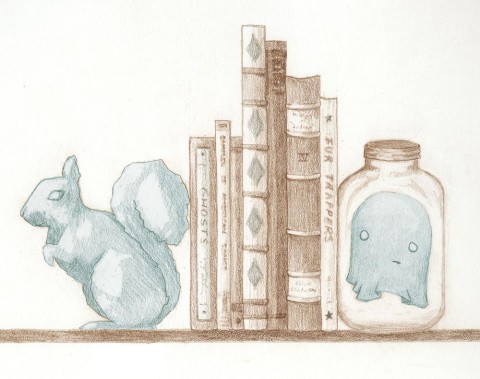There was controversy when ghosts started showing up in exotic pet boutiques in Brooklyn. When asked for an explanation of what the ghosts were, storeowners would say the ghosts were a form of gas, a vapor, which had something like consciousness.
Like a human? They were asked.
No, not at all, they replied, more like a fish, if even. When asked about where they came from, pet store owners said, we have a supplier in Japan. These ghosts are popular in Japan.
People still asked questions, came up with theories, and picketed outside stores. Their signs had slogans like Don’t buy the dead and My ancestors are not for sale. People looking to be litigious crossed picket lines to purchase ghosts. Sales boomed.
When a customer paid for a ghost he or she received a two-gallon glass jar, a bag of food that looked and felt like marshmallows, and a pamphlet titled The Proper Care and Feeding of Your New Pet Ghost. As well as instructions for feeding (one pellet per day), cleaning (Wipe the glass once a week), and care of ghosts (Don’t leave your ghost alone for too long, and sing to it), the pamphlet contained this warning: It is unknown what will happen if you come into direct contact with a ghost. A few tests have been conducted but there is no consistent result. If you wish to make physical contact with your pet ghost, proceed with caution.
This warning stirred discussion. People speculated wildly. Soon enough, videos of ghosts being touched appeared on the Internet. Some ghosts melted like ice sculptures. Others flew out of frame like a balloon letting out its air. There was one chilling video that was talked about, but not many people, if any, saw it. According to people who claimed to have seen it, the video showed a young girl, maybe twelve years old, reaching into a jar containing a ghost. When she touched it, she froze. Her body became rigid and blue. Her father, panicked, rushed into the frame and knocked her body over. Her arm broke in the fall. The rumors of this video were enough to reignite protests. Legislation was passed preventing the sale of ghosts to minors, but sales were largely unaffected.
When asked why they bought ghosts, people said they were cute. The ghosts looked like you think they might. They were the size of coffee mugs, rounded at the top, and their bottoms curved and curled like the ends of drapes. They were quieter than other pets was another common answer. Only when prompted would they coo and whistle. They could mimic melodies, and they could be taught to sing harmony as well. This made them popular with music teachers, who would keep ghosts in their classrooms and use them to help teach. One ambitious composer created a symphony made entirely of ghost sounds. It opened to mixed reviews. This statement from a Chicago critic summed up the general consensus, “While the use of ghosts was compelling, the composition itself was the same kind of middling, post-modernist minimalism we’ve been hearing since the mid-sixties.” After this performance, ghosts started to appear in sitcoms and sketches on late night talk shows. A fledgling musician from Tampa released a novelty single called “Ghost Bop.” The market had been saturated, and while sales remained high, early adopters moved on to carrying iguanas on their shoulders in public.
Soon enough, ghosts were turned loose on the streets. Occasionally, children would find frozen squirrels and stray cats. These became prized possessions, which could be sold for entire months of allowances, or traded for stolen cigarettes and watered down whiskey. It was for this reason schools decided they were contraband. Entire boxes in principals’ offices were filled with these frozen animals. They don’t decay. One can still find these blue creatures in flea markets and online auctions. They’re cheap now, but years down the road, when domesticated ghosts work their way through the nostalgia cycle, the cost of frozen animals will skyrocket, as kids who never had anything worth trading will want to display them on their coffee tables.
Other people, the ones who protested the sale of ghosts, opened shelters. The first newspaper piece to cover ghost shelters jokingly called them graveyards. Many places took kindly to this title and named their businesses things like The Brindlehook Family Cemetery. The back rooms of the shelters are lined with glass boxes filled with ghosts cooing and whistling the songs their previous owners had taught them. Occasionally, a shelter will have a group of ghosts who all know the same songs. These ghosts will sing together in haunting harmonies. Other groups will imitate instruments and perform full vocal arrangements of top forty hits. When shelters get groups like this, they move these ghosts to the storefront in hopes their performance will inspire passers-by to adopt. This tactic rarely works. Mostly, it inspires people to drop a dollar or two in a donation box and continue about their business.
Still, not all ghosts are brought to shelters. Some go feral, finding their way to old, actual, cemeteries and abandoned properties. The few studies done on feral ghosts show they grow bigger on their own. Nobody knows what feral ghosts eat, but people assume it must be mice, rabbits, rats, possibly small birds. Some say the protein in their diet enables them to grow large. Others say it’s the lack of confinement. Either way these ghosts are the ghosts we’ve become familiar with. These things we’ve abandoned and forgotten learn to imitate our voices and shapes. They learn to hide in the corners of our eyes.



 The SmokeLong Grand Micro Contest (The Mikey) is now an annual competition celebrating and compensating the best micro fiction and nonfiction online.
The SmokeLong Grand Micro Contest (The Mikey) is now an annual competition celebrating and compensating the best micro fiction and nonfiction online.